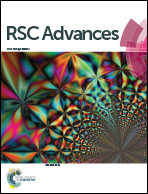Preparation of a ZnO nanoparticles/multiwalled carbon nanotubes/carbon paste electrode as a sensitive tool for capecitabine determination in real samples
Abstract
The present study describes the fabrication of a sensitive electrochemical sensor for the determination of capecitabine (Cap). The zinc oxide nanoparticles/multiwalled carbon nanotubes (ZnO/MWCNT) modified carbon paste electrode (CPE) is proposed as a novel electrocatalytic system for the reduction of Cap. Scanning electron microscopy (SEM), X-ray diffraction measurements (XRD) and differential pulse voltammetry (DPV) were used to characterize the performance and microstructure of the sensor. The electrochemical reduction of Cap was investigated at the ZnO/MWCNTs/CPE by the use of DPV. The developed electrode exhibited excellent electrochemical activity towards the electrochemical reduction of Cap. The sensor shows a linear range from 0.10 μmol L−1 to 100.00 μmol L−1 with a detection limit of 0.03 μmol L−1 at a signal to noise ratio of 3. The modified electrode has excellent analytical performance and can be successfully applied in the determination of Cap in biological systems.


 Please wait while we load your content...
Please wait while we load your content...